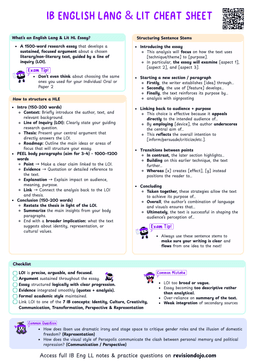IB English Language and Literature Paper 1 Exemplar

Making It Real
- To fully understand the purpose behind each detail in the Dettol campaign, it’s essential to consider both the author’s intentions and the audience’s mindset.
- So, let’s place ourselves in the position of a reader:
- It’s 2020, in the midst of the COVID-19 pandemic. You’re stuck at home, constantly reminded of hygiene guidelines, feeling mentally drained, and maybe even rethinking your job or routine.
- You come across a bold, engaging Dettol advertisement in your feed or on a billboard. It’s bright, witty, and oddly empowering. It doesn’t just sell you a disinfectant, it taps into your current state of mind.
- From this setup, the creator of the ad would be asking:
- Who is most likely to be feeling disillusioned with traditional work routines and in need of empowerment or change?
- How can Dettol’s campaign attract attention and resonate with people navigating pandemic stress and remote work?
- How can the ad feel motivational, personal, and relevant to ensure people associate Dettol with not just hygiene, but optimism, control, and daily empowerment?
Pre-planning (Dettol Advertisement)
- Before beginning your annotation or analysis, clarify the foundational elements of the text:
- Text Type: Advertisement (Print and Digital Campaign)
- Overall Purpose:
- To promote Dettol as more than a hygiene product, positioning it as a symbol of empowerment, optimism, and leadership during the pandemic.
- The campaign aims to reinforce brand identity, encourage brand loyalty, and ultimately increase sales by connecting emotionally with readers navigating remote work and public health concerns.
Target Audience(s)
- Working adults (especially those working from home during the pandemic)
- These are individuals frustrated with conventional work structures and looking for purpose, routine, or motivation during uncertain times.
(This is the primary audience for the text.)
- These are individuals frustrated with conventional work structures and looking for purpose, routine, or motivation during uncertain times.
- Health-conscious individuals
- Those already interested in cleanliness and hygiene during the pandemic and who are likely to purchase disinfectant products regularly.
- Everyday consumers affected by COVID-related changes
- This includes middle-class individuals across Britain dealing with lockdown fatigue, seeking some control or reassurance in their daily routines.
- The typical demographic includes middle to lower-middle class individuals in the UK, many of whom are either working from home, unemployed, or facing personal or professional uncertainty during 2020.
- In your analysis, be sure to explore how Dettol’s understanding of its audience shaped the campaign’s tone, structure, and use of persuasive techniques.
- You do not need to mention all audience types just the ones most relevant to your argument.
Exemplar Plan: Dettol Campaign (2020)
Structure:
Each paragraph is based on a distinct idea that supports the overall thesis.
Thesis
The Dettol campaign reimagines a hygiene product as a symbol of empowerment during the COVID-19 pandemic. Through colloquial tone, irony, motivational rhetoric, and deliberate visual design, the campaign appeals to lower to middle-class Britons working from home, ultimately strengthening Dettol’s identity as a socially aware and essential brand.
Bird’s Eye View
- Dettol draws on pandemic-specific context and cultural references to create resonance and relatability.
- The campaign uses motivational tone and irony to encourage personal agency and emotional engagement.
- Language devices such as listing, metaphor, and humour are employed to reinforce relatability and brand positioning.
- Visual elements like colour, image, and layout are strategically designed to enhance brand recognition and emotional appeal.
Why this structure works well
- This structure effectively divides the thesis into four focused, idea-based sections that allow for precise analysis.
- Each paragraph addresses a different strategy used by the advertisement, offering strong textual evidence and explaining its impact.
- This ensures comprehensive coverage of the text and facilitates a logically progressive essay structure.
- You may find it helpful to think of these questions when planning:
- How does Dettol use context to enhance relevance?
- How does tone reinforce purpose and connect with the reader?
- What language devices make the message persuasive and memorable?
- How do visuals contribute to audience engagement and brand identity?
Point 1: Dettol uses pandemic context and cultural references to create emotional resonance.
- “Wake up whenever. No suits. No ties. No rules.”
- The use of irony and a list of short, fragmented clauses
- Mocks rigid office routines and provides comic relief, aligning with readers' pandemic fatigue.
- “Sticky tube floors”
- A cultural in-joke familiar to British readers
- Builds ethos and relatability, presenting Dettol as a brand that understands its audience.
- September 2020 campaign launch
- Aligns with remote work culture and heightened public concern over hygiene
- Demonstrates contextual awareness and reinforces Dettol’s relevance.


